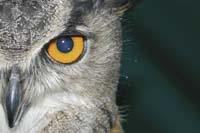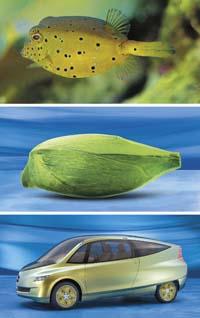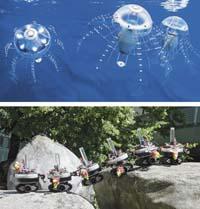Biomimetics, teacher of nature

What does not serve does not advance. It is the law of nature: unsuccessful designs disappear or become fossils. Plants, animals, bacteria, etc. That they have survived such a strict law are excellent optimization models. Therefore, voluntarily or involuntarily, we have always applied the observed in nature for our use. However, in recent years, the value of this source of inspiration is becoming increasingly clear, and for many, the consideration of nature as a teacher is becoming a systematic form of work.
The lesson has been well learned by Eiji Nakatsu, engineer in charge of testing Shinkansen bullet trains in Japan. Shinkans trains are the fastest in the world, they do not fly, but owes much to the birds.
Being fast is not a problem with current technology, but the real challenge is not to be too noisy. The faster it is, the more noisy the train is. To solve this problem, Nakatsu, pulling out of his love for birds, set himself on the ability of owls to fly without just sounding.
Thus, the Noker team began to investigate this capacity of destruction and found that one of the secrets of silence was in the structure of some feathers on the wings. These feathers have sawn edges, which allows them to form small swirls in the air. These small trailers break the larger trailers that produce sound and, therefore, eliminate sound.
It took four years to try to apply this principle to the train. But finally, at certain points of the train (the pantograph), by applying this sawing of the owl feathers, the train was obtained that meets the most demanding sound standards in the world.
However, I still had another problem. When entering at high speed in the tunnels, pressure waves are generated that become increasingly large and that when leaving the tunnel cause a sound explosion. This is because when entering the tunnel the air resistance changes sharply.

Taking into account the subject previously taken from nature, Nakatsu began to think: "Are there living beings adapted to sudden changes of resistance? ". And it occurred to him another bird: the kingfisher. To capture the fish, the kingfisher must move from low-resistance air to high-strength water. No splashes!
The key could be in the demanding and aerodynamic peak of the kingfisher martin. And taking this into account, they began to do tests. They soon realized that the most suitable form for the end of Shinkansena was almost identical to the peak of the kingfisher. In this way, the train was equipped with a peak of 15 meters, which allowed to reduce the air pressure by 30% increasing the speed by 10% and the energy consumption by 15%.
Expert Flyers
The birds also interest the US Air Force. And it is that if birds are masters in something, teachers fly, they have nothing in common with insects and bats. Unlike our planes, the wings fly agitated and have the ability to change the position and shape of the wings. Thanks to this, they are able to resist gusts of wind, rain and snow without falling to the ground.
That's what the US Air Force wants: a small unmanned aircraft capable of flying like birds and insects. For this purpose, it allocates more than a million dollars a year. However, they have only started and there is a long way to go.

However, the fact that large aircraft shake their wings is not very likely, but without going so far, more efficient aircraft can be made by taking care of birds. Penn State University of Pennsylvania, in a project funded by NASA, has designed wings that change shape. In fact, sorbels, for example, keep wings well spread to fly for a long time and spending little energy, or a little more concentrated when they need faster and more precise movements.
Thus, they first developed a skeleton capable of changing shape. But the skin that would cover this skeleton could not be rigid either. To solve it they have been inspired by fish. The bark is formed by superimposed foils, as well as scales of fish.
Learn from fish
Fish scales can also be a source of inspiration. Sharks, for example, have an interesting design; it is observed closely that they present longitudinal striations. Thanks to these scales, the shark friction in the water is very low and the skin is kept clean, without ecoparasites -- in the sea is difficult.
This has been applied, for example, in the costumes of elite swimmers and in the hulls of the boats. With the new coatings that mimic the texture of the sharks scales have managed to reduce by 67% the number of living beings that stick in the helmets, leaving the hull completely clean at a speed of 4-5 knots. Therefore, in these ships it is not necessary to use biocides pollutants.

And the sharks were precisely the first fish that the group of Dieter Gurtler touched them. Gurtler, engineer of the gigantic car company Daimler AG, traveled with two other members to a natural history museum in the Sttutgart area to look for new ideas in fish to develop small and efficient cars. Sharks were soon discarded: their shape is not adequate if you want to have a large space inside.
The museum specialist taught them a rare fish: the tropical fish box ( Ostracion cubicus ). It was thick and broad, not very elegant, and seemed clumsy. However, after performing 3D simulations, the researchers found that the shape of the fish box is very effective in moving. These fish do not move fast, but they stop and depart, and in zigzag they have nothing in common.
Gurtler's team continued with the idea. When they made a plaster model and tested it in the wind tunnel they were fascinated: it was very close to the most perfect aerodynamic model. In the end they developed the model of a new car from this singular fish: The bionic Mercedes-Benz.
And aerodinamicity was not the only feature that interested them from the fish box. It was also discovered by the fish skeleton. The hexagonal plates form a very light but hard skeleton. They spent months inventing how to apply this structure to the car, but finally applied it in door panels and chassis. These parts reduced their weight by 30% and the tests showed that the new structure was 40% more rigid than the standard model.
Many researchers who have received this kind of lessons from nature have come to the conclusion that from the observation of nature we can obtain ideas that would not happen to us otherwise. Therefore, biomimetics have more and more followers. Ford has developed a shock-avoidance system mimicking the otis flight mechanism in large groups; the company Whalepower has copied the Xibart fins to make the most efficient fins of wind mills and turbines; the University of Arizona is investigating the application of the power generation capacity of the leaves for the manufacture of solar panels at molecular level; and the Japanese doctors have manufactured similar hype needles to mosquito.

Technology of nature
Janine Benyus has written several books on this subject and is the founder of the non-profit Biomimicry Institute and the consultant Biomimicry Guild. He believes that the mechanisms developed by nature can be very useful for the human being, and that is what he intends to demonstrate to engineers and designers.
One of Benyus's projects is Nature's 100 Best Technologies (N100B). The aim of this project is to identify the 'technologies' of nature that can serve to make a more healthy and sustainable planet. Every year they want to publish a book with a hundred ideas.
Among the ideas that make up the first list is, for example, the system of air conditioning of termites. In the city of Harare of Zimbabwe there is a building built with this idea: Eastgate Building. Architect Mick Pearce and Arup Associates engineers investigated the buildings of the Macrotermes michaelseni termites. In fact, inside these buildings only usually present a degree difference, although the outside temperature varies between 3 and 42 °C.
The daily temperature also varies between 10-40ºC. However, the Eastgate Building maintains a pleasant temperature throughout the day without using air conditioning. Eastgate Building consumes only 10% of the energy that would use a custom-made normal construction.

Another example is the surfaces that are cleaned. It is an idea taken from the lotus plant ( Nelumbo sp ). The surface of the leaves of the lotus is one of the most hydrophobes -- water repellent. Thanks to the microstructure of the surface, the drops of water remain spherical, which when slipping on the leaf drag the particles of dust and dirt. This is what is known as the lotus effect and different applications have already been applied: paintings, covers, fabrics...
The ingenuity of nature has no limits. The peak of the toucan masterfully combines lightness and strength, and the thorns of the hedgehog are a wonderful example of structural economy and hardness. The fireflies create a cold light without loss of energy and the beetle Melanophila, which lays eggs in freshly roasted wood, is able to detect infrared radiation emitted by forest fires at a distance of hundreds of kilometers. 3,800 million years are not wasted.






